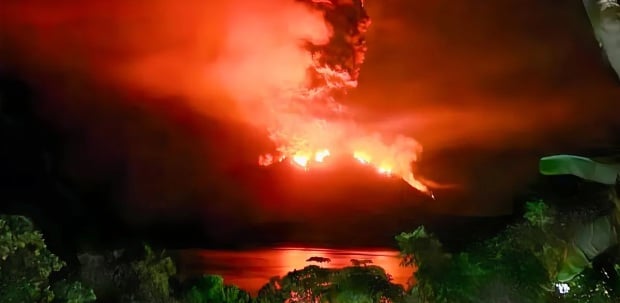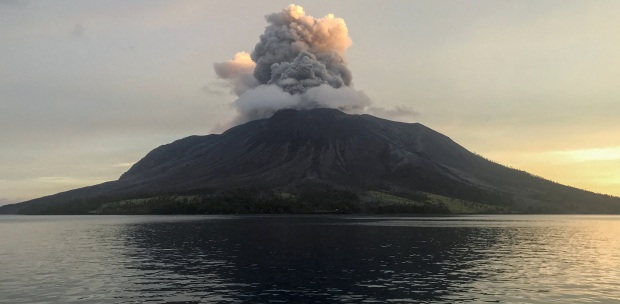As the world swelters through record temperatures, scientists say an unusual culprit may be partly to blame: an underwater volcanic eruption off Tonga in the South Pacific last year.
While most big blasts cool the planet with a sun-dimming haze, the eruption of Hunga Tonga-Hunga Ha'apai in January last year blew the equivalent of 60,000 Olympic swimming pools of water into the stratosphere, high above the planet.
Water vapour is a natural greenhouse gas, trapping heat as it swirls around the globe. By contrast, major land eruptions — such as Pinatubo in the Philippines in 1991 — temporarily dim sunshine with an ashen sunshade before falling back to Earth.
"The majority of volcanoes will have a cooling effect," said Peter Thorne, a professor of climate science at Maynooth University in Ireland. The Tongan volcano "is an exception to the rule and a significant wild card we haven't seen before".
The June-August period this year was the warmest on record worldwide by a puzzlingly wide margin, with heatwaves occurring from Japan to the United States.
Humanity's greenhouse gas emissions are overwhelmingly to blame, scientists say, with less certain contributions from an El Nino weather event warming the Pacific, limits on light-reflecting pollution from shipping fuels and the volcano.
Many scientists say more research into volcanoes is vital to gauge how far eruptions can briefly affect the long-term trend of global warming, driven by burning fossil fuels.
The 2015 Paris Agreement seeks to limit the rise in average temperatures to 1.5°C above pre-industrial times to avert the worst of climate change, from floods to wildfires. Temperatures are already up 1.2°C.
The eruption in the Polynesian archipelago ejected 150 million-odd tonnes of water vapour into the stratosphere, about 10 per cent of the 1.4 billion tonnes typically swirling there, said Margot Clyne, an atmospheric scientist at the University of Colorado, Boulder, in the US.
"We can say with pretty good confidence that a volcanic eruption like this didn't happen all the way back ... to the 1880s, when Krakatoa erupted in 1883," she said.
The eruption also blew about 500,000 tonnes of sulphur dioxide into the stratosphere, which tends to cool the planet. That mix of water and sulphur complicates the volcano's impact.
A study in the journal Nature in January said the eruption slightly increased the risk that global temperatures would temporarily breach 1.5C in at least one of the next five years.
"This is the first volcano in the observational record that may warm rather than cool the surface," said Luis Millan, a scientist at the National Aeronautics and Space Administration's Jet Propulsion Laboratory at the California Institute of Technology.
Preliminary studies suggested that the "water plume may last up to around eight years in the stratosphere", the layer of the atmosphere about 10km to 50km above Earth, he said.
Holger Voemel, a senior scientist at the US National Center for Atmospheric Research, said it was possible that the eruption would have some effect on global warming.
"But I think the verdict is still out," Voemel said.
Sun-dimming eruptions have happened roughly twice a century in the past 2,500 years, most recently Pinatubo, according to the United Nations' Intergovernmental Panel on Climate Change (IPCC). Pinatubo cut average global temperatures by about 0.5°C for more than a year by dimming sunlight.
In the past 2,500 years, there have been about eight even bigger eruptions, according to the IPCC. Tambora in Indonesia in 1815 led to a "year without a summer", with failed harvests from France to the US.
Even worse, the eruption of Samalas in Indonesia around 1257 led to famines and may have kicked off the Little Ice Age, an unusually cool period that lasted until the 19th century.
The IPCC says at least one Pinatubo-style eruption is likely this century but that volcanoes have had a negligible effect on the overall trend of global warming driven by human greenhouse gas emissions since the Industrial Revolution.
"Volcanic activity is irregular, unpredictable and uncontrollable," said Ingo Bethke, of the Bjerknes Centre for Climate Research at the University of Bergen in Norway. Bethke and Thorne argue that the IPCC should do more to examine the risks of a string of eruptions.
"We can deal with one Pinatubo, but several would be a major stress test for society on top of climate change," Thorne said.
* The writer is from the Reuters news agency






